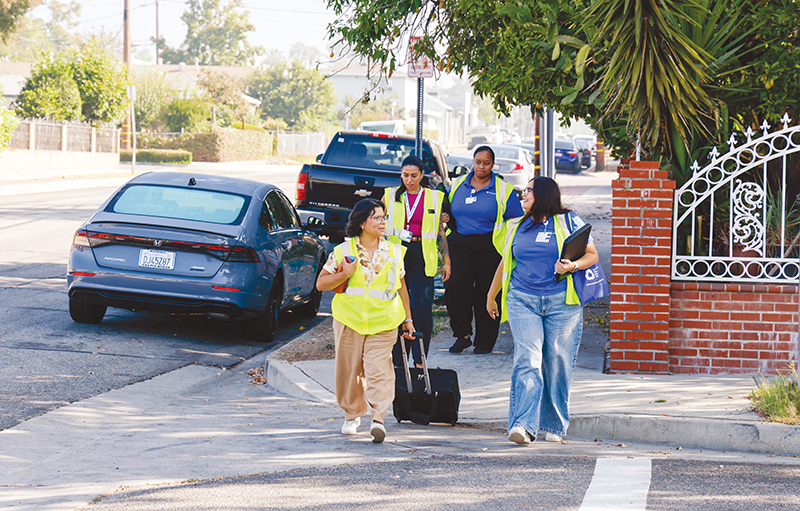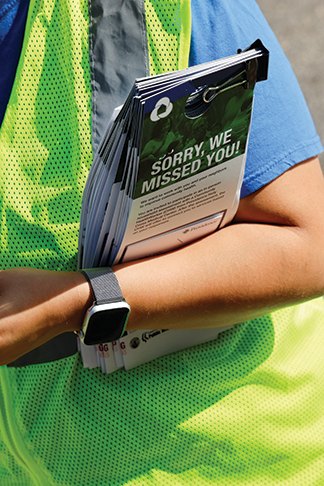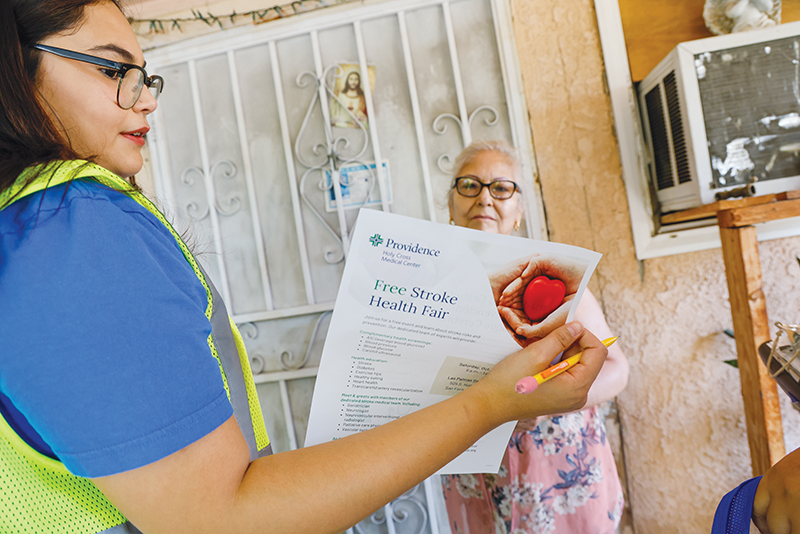SAN FERNANDO, California — Map in hand, yellow safety vests on, questionnaires on their clipboards, the community health team from the Providence St. Joseph Health system sets out for another morning of knocking on the doors
of homes in San Fernando, just north of Los Angeles.
If they're lucky, that is. Many yards have gates. For safety and privacy reasons, team members don't open the gates to get to a door. Some yards have dogs. Some have Ring or other security cameras.
"I'm Scarlett from Providence," says community health worker Scarlett Diaz, standing on a front porch, looking into a camera, talking to the faceless voice of the resident. "We were wondering if you would be available to answer some questions regarding
any resources that you might be needing or any concerns that you might be having with the community? Would you be interested? We can come back another time."
The voice tells her to come back another time.
Diaz steps back down from the porch and toward the sidewalk. "I can talk to Ring cameras," she says. "I'm used to that."
Sometimes team members get to talk to residents like student Fatima Vazquez. The 28-year-old answers the workers' household assessment questions and asks them about resources for affordable dental care.
"It's good for neighbors who have more concerns, and maybe don't have enough of a voice, especially people who might be undocumented," Vazquez says of the household assessment. "They might not be getting the resources they need, or the knowledge of the
resources, especially for Spanish speakers. I feel like it's harder for them to find out about resources and get help with that. So it's good."
The door-to-door pilot project, led by Los Angeles County's public health department, has launched in 10 high-priority areas identified
as having the most need. Providence is among other health and service agencies partnering with the health department to send teams to knock on doors. Teams are hired from the target areas, and the project will continue for five years. The hope is
to reach 8,000-13,000 households in each service area. As of Oct. 4, teams countywide conducted over 27,000 visits, including return visits, to a total of 9,020 unique homes and completed 1,557 household assessments.
A $75 million federal grant spread out over the five years funds the program. Providence is tapping community benefit dollars to support teams in its service areas.

A team from Providence and the Los Angeles County Department of Public Health sets out in San Fernando, just north of Los Angeles, to reach out to residents. The team is part of a project that has launched in 10 high-priority areas in Los Angeles
County identified as having the most need. Photo by Glenn Marzano
Getting details at the doors
Providence teams are knocking on doors in San Fernando and in the South Bay and Wilmington neighborhoods, just south of Los Angeles.
The teams ask residents about food accessibility, health care accessibility, and safety concerns. If the residents identify a need, workers will suggest a resource or get back to the residents with one. They tell residents about upcoming dates for community
convenings, which they host every few months to tell people more about the project and answer questions.
The first 50 people to come to the next convening in San Fernando, they tell residents, will get a box of fresh produce.
It's both a lure and a thank you, much like the branded tote bags or packages of disinfectant wipes they give to residents who talk to them.
It's a small gesture, but not the only thing needed to build a relationship, the workers say.
"One thing I like to do is encourage people to tell a friend, tell their neighbor, because the word of mouth is so valuable for us," says Sandra Trinidad, a liaison from the health department who walks with the group this morning. "Even a few doors down
we can say, 'Hey, we just talked to your neighbor.' We can name drop."
If residents don't answer, the team leaves a hang tag with contact information in both English and Spanish. "¡Lo sentimos no hableros encontrado!" it says. "We're sorry we missed you!"
Building relationships
Barbara Ferrer, director of the Los Angeles County Department of Public Health, led a workgroup of community partners in developing this Community Public Health Team project, partly inspired by the health care
infrastructure in Cuba and Costa Rica. Each team visits homes in their service area to offer a household assessment and connection to care.
 If nobody is home or the door to a home is behind a gate, the team leaves a hang tag with information about the project. Photo by Glenn Marzano
If nobody is home or the door to a home is behind a gate, the team leaves a hang tag with information about the project. Photo by Glenn Marzano
Anthony Ortiz Luis, the Providence community health director in charge of the San Fernando Valley area, says the household assessments are a public health model for improving health outcomes of underserved communities. "This is the first project in the
United States that's really looking at how we develop individual, one-on-one relationships with high-need, vulnerable communities, and really trying to find out what their exact needs are," he says.
Tiffany Romo, director of the community engagement unit at the Los Angeles County Department of Public Health, says the effort built on work that continued throughout the COVID-19 pandemic.
"The relationships they already had in place with the community were imperative to all the information we were trying to put out during the pandemic, especially early on, when the information was rapidly changing," she says.
The community's trust in partners like Providence helps immensely, Romo says. "Reputation is everything in these spaces, and people know them," she says. "That is so core."
For example, people might recognize the Providence name from going to a food distribution that the health system has helped organize, she says, and then respond to the workers who come to the door. "I think one of the core values of the project is community
engagement and having community voice present in every aspect," Romo adds.
The community health workers input residents' responses to a database. The health department and partners plan to use that information for immediate and long-term solutions to issues. For example, if people say they have a hard time getting access to
healthy food, the partners may look at a food distribution campaign or go to business leaders to open a grocery store. If people complain about a dangerous intersection and say local government leaders are acting slowly, the health department might
inquire and push officials for a fix.
Giving people a voice
Each morning or afternoon, community health workers set out in teams of at least two to knock on doors and ring bells of about two dozen homes. Not everyone is interested in answering questions.
"I don't want to talk about health care, insurance, nothing," says one man the team approached on the sidewalk in front of his home.

Scarlett Diaz, a Providence St. Joseph Health community health worker, talks to Lucia Flores on the porch of Flores' home in San Fernando, California. Diaz is part of a Community Public Health Team project that goes door to door to ask residents
about their health needs or concerns with the community. Photo by Glenn Marzano
The success rate so far in reaching people and connecting them to resources is about 5%. That may not seem like much, but Romo is not discouraged.
"We just got started, right? Part of it is building up that trust," she says. "But I think I'm actually really excited that we were able to get 5%, 6% at this time, because if you think about it, there's just so many reasons why folks wouldn't open the
door."
It takes time to build relationships and for teams to develop the ability to communicate with residents effectively, Romo says. "It's not just about that initial opening of the door," she says. "It's about how do you establish a relationship, so they
continue to open the door over the next five years."
Some residents, recognizing that the teams are there to help, are willing to talk. One older woman named Jessie, who prefers her last name not be used, complains about the lack of parking in the neighborhood and of the curse words she hears from elementary
schoolchildren who play nearby.
"I mean, I grew up in a generation where, you know, if you said stupid, you were reprimanded," she says to the team as she stands in her driveway. "And now these kids, the language that comes out of their mouths, I'm appalled."
She says she thought some of the children could benefit from mental health services.
Lucia Flores, 74, tells the workers who come to her door that she is very familiar with Providence. She worked for 27 years at Providence Holy Cross Medical Center in Mission Hills, California, as a unit clerk. She doesn't have any particular health needs
or concerns herself, she says in Spanish through a translator, but likes what the teams are doing.
"It's a good opportunity for those who aren't able to go out and get resources," she says. "It's great to have that. I'm a lucky one, so far."
One morning's results
On this particular morning, the team went to 25 homes, got four people to respond to a short version of the household assessment, and got four refusals. They were happy with the outcome.
Community health worker Ashley Jackson grew up in nearby Pacoima, one of the census tracts the teams are focusing on. Jackson says some of the resources, such as access to fresh food, that are needed now were needed back then. "It's good to have something
like this now, to know that there's this organization that's coming out and meeting your needs or helping you," she says.
Diaz, who studied public health in college, says that she's always wanted to be a bridge between health care and helping people get what they need.
"With Providence, especially with their values, and having empathy and serving the poor and vulnerable, I feel like that's a great opportunity to do that here," she says.
"It definitely feels good."